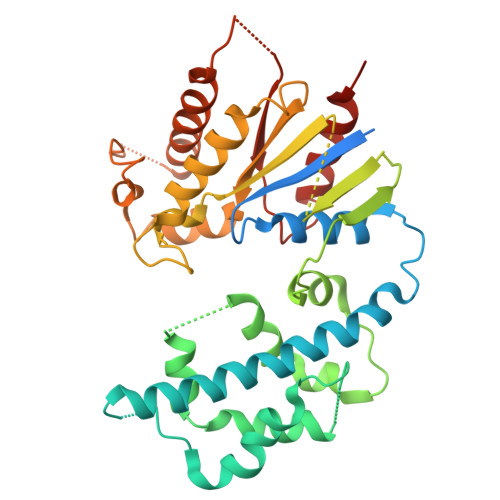Structure-function analysis of plant G-protein regulatory mechanisms identifies key G alpha-RGS protein interactions.
Torres-Rodriguez, M.D., Lee, S.G., Roy Choudhury, S., Paul, R., Selvam, B., Shukla, D., Jez, J.M., Pandey, S.(2024) J Biol Chem 300: 107252-107252
- PubMed: 38569936
- DOI: https://doi.org/10.1016/j.jbc.2024.107252
- Primary Citation of Related Structures:
8VGA, 8VGB - PubMed Abstract:
Heterotrimeric GTP-binding protein alpha subunit (Gα) and its cognate regulator of G-protein signaling (RGS) protein transduce signals in eukaryotes spanning protists, amoeba, animals, fungi, and plants. The core catalytic mechanisms of the GTPase activity of Gα and the interaction interface with RGS for the acceleration of GTP hydrolysis seem to be conserved across these groups; however, the RGS gene is under low selective pressure in plants, resulting in its frequent loss. Our current understanding of the structural basis of Gα:RGS regulation in plants has been shaped by Arabidopsis Gα, (AtGPA1), which has a cognate RGS protein. To gain a comprehensive understanding of this regulation beyond Arabidopsis, we obtained the x-ray crystal structures of Oryza sativa Gα, which has no RGS, and Selaginella moellendorffi (a lycophyte) Gα that has low sequence similarity with AtGPA1 but has an RGS. We show that the three-dimensional structure, protein-protein interaction with RGS, and the dynamic features of these Gα are similar to AtGPA1 and metazoan Gα. Molecular dynamic simulation of the Gα-RGS interaction identifies the contacts established by specific residues of the switch regions of GTP-bound Gα, crucial for this interaction, but finds no significant difference due to specific amino acid substitutions. Together, our data provide valuable insights into the regulatory mechanisms of plant G-proteins but do not support the hypothesis of adaptive co-evolution of Gα:RGS proteins in plants.
Organizational Affiliation:
Donald Danforth Plant Science Center, St Louis, Missouri, USA.
















